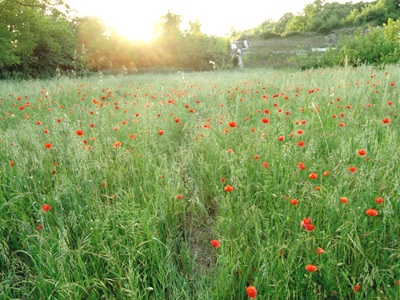Rome Diary - Part III
30 April
Went with a small group to the Palazzo Spada today. It is located very near to the Palazzo Farnese, and constructed around the same time, circa 1540. The Italian Council of State meet in its lavishly frescoed and stuccoed rooms, today.
Astronomical charts are inscribed on the ceiling in the upstairs corridor, with arcs radiating from a tiny window placed very high in the wall. I could not help associating the cosmic order related to the passage of light that passes through this aperture with the principle of linear perspective that underlies the optical/photographic image.
This hall is lined with antique marble friezes, with elements that come out of the shallow relief picture plane as full blown sculptures. Unfortunately, taking photos was forbidden.
The interface with illusion and reality seems to set the theme throughout. Frescos play with trompe l’oeil illusion involving figurative narratives framed by faux architectural and sculptural forms. In the room where the story of Cupid and Psyche is told, human and mythical figures strive to escape their architectural setting and two dimensional state.

Photo: Fresco detail in Room of Cupid and Psyche, Palazzo Spada. (www.corbis.co.in)
In another, various battle scenes are framed by pregnant caryatids (sculpted female figures taking the place of pillars) who have assimilated with their architectural setting. Fertility contrasts with war, but the dynamic of becoming associated with pregnancy is frozen here, perhaps highlighting the limitations of painting, sculpture and architecture, all of which are represented. As large sections of this fresco are missing, replaced by blank negative spaces, time is seen to slowly reverse that process.
We were permitted to take a few photos in the large chamber where the Council of State sits. This room is known as the Lounge of Pompey due to a large marble statue of the late Roman Republic leader. Here, a painted bird in a gilded cage seems to allude to the state of the figures spaced throughout the architectural setting.

Photo: Details from fresco in Lounge of Pompey, Palazzo Spada.
Each figure gestures to the location of another on an opposing wall, or in the case of one on an upper balcony, spies upon them through a telescope that is also directed toward the entrance, as if returning the gaze of the viewers who enter to find themselves enframed within the context of its painted residents. I found myself spinning around in response to the cross wall dialogue.

The play with illusion and reality is perhaps best realised with an arcade built in the garden by Borromini circa, 1630’s. Here diminishing scale and a rising floor creates the appearance of a long tunnel leading to a life size statue when the corridor is only 8 meters long and the statue just 60 cm high!

Photo: Forced perspective gallery by Francesco Borromini, Palazzo Spada.
Peter, The Rome Fellow at the BSR, shouted me a coffee on the way back, showed me a library loaded floor to ceiling with very old books (like something from a Harry Potter set), and introduced me to a supermarket near the Pantheon, that has frescoes on its ceiling.

Photo: Dr Peter Fane-Saunders, at the Palazzo Spada, assuming the pose of a human pillar.
1 May
I have been in Rome for one month, and decided it was time I got serious about aqueducts. Headed south to a park on the city’s fringes famous for a convergence of these arched wonders of ancient plumbing.
I left late, hoping to catch the golden afternoon light, and found the metro chockers with the faithful returning from the Beatification of Pope John Paul. This no doubt contributed to the hordes strolling and picnicking in the park that I had been told is usually relatively isolated. I hiked across a field of barley to gain a distant vantage point and followed the rail line that is adjacent to the Aqua Claudia. At its south eastern end a long section is virtually in tact, but its northern trajectory is reduced to a dotted line of ruins cut by the train line.


Photo: Aqua Claudia’s broken remains intersected by the train line (north western end).
A line of high-rise apartments receding at right angles to the aqueduct seemed to repeat the theme of intersection.
The park attracts amorous couples and the arches of the aqueduct in this more remote region seemed particularly busy. The Latin word for arch is fornix, and it would seem the historical activity associated with its span, continues.
On my return journey I encountered the relatively “modern” Aqua Felice. Completed in 1585, it presents more as a stout wall by contrast to the grace of the Aqua Claudia. Its obstruction in the landscape, however, makes the peep hole view offered through its squat arches more appealing. (...And that has nothing to do with the last paragraph!)

Photo: Aqua Felice.
6 May
I have let my diary lag and need to catch up.
I did some painting this week.

On Wednesday evening I went out to an exhibition opening with some of the resident artists, one of whom knew the young British artist who was exhibiting.
The city in the fading evening light was magic. We had dinner at a little restaurant called Baffetto, which provided rustic, wood fired pizzas with a jug of wine and bottle of mineral water for under 8 euros each. This was followed by an amazing ice-cream at the gelateria opposite for 2 Euros. I had black cherry and caramel with biscuit dipped in chocolate!
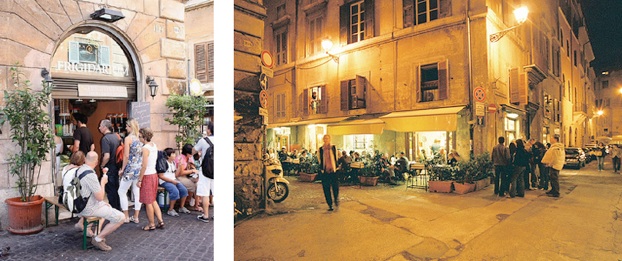
Photo: The queues suggest Frigidarium and Baffetto serve the best ice-cream and pizza in Rome.
Thursday and Friday were open studio days where people from the Rome Contemporary Art Fair wandered through. I suspected my work did not fit their envelope when painting was justified as being “just like Photoshop”. This was confirmed at the Fair where; canvases were shaped, slashed and turned to face the wall (the inclusion of Fontana originals dating the concept as more than 50 years old), but with hardly a decent painting to be found. Photos made predictable attempts to shock with references to sex, deprivation and death; consumer detritus was gilded gold; and lots of stuff purported to be about “climate change”. The most confronting aspect of the show was perhaps its venue. The paraphernalia from its former function as a slaughterhouse providing what was absent from the “shlock” on display.
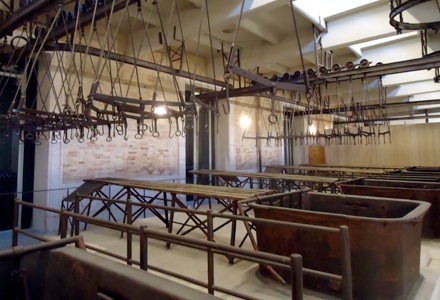
Photo: The Museum of Contemporary Art of Rome (MACRO) in the old slaughterhouse at Testaccio.
7 May
Following the model of Baudelaire’s flaneur, I strolled through the city with no purpose other than experiencing the city. I found Pope bottle-openers (Popeners?) near St Peters, which I thought amusing, especially since I know bottle-openers colloquially as “church-keys”.

Photo: The first Pope with keys to the kingdom and ‘church-keys’ featuring the last two Popes.
I tested the papal church-keys on a couple of Peronies in the evening and concluded the plain Pope John Paul (left) was superior to the fancy Pope Benedict (right) ...although more testing may be required!
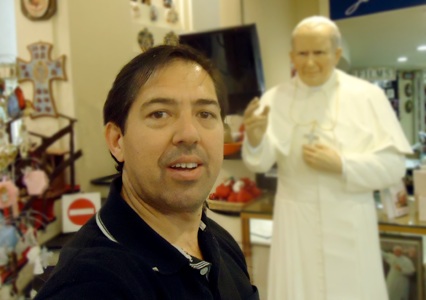
Photo: Pope John Paul watches over the merchandise in a religious knickknack store.
As a change of pace from my usual interest in architecture I paid attention to the stylish shop window displays that I passed.
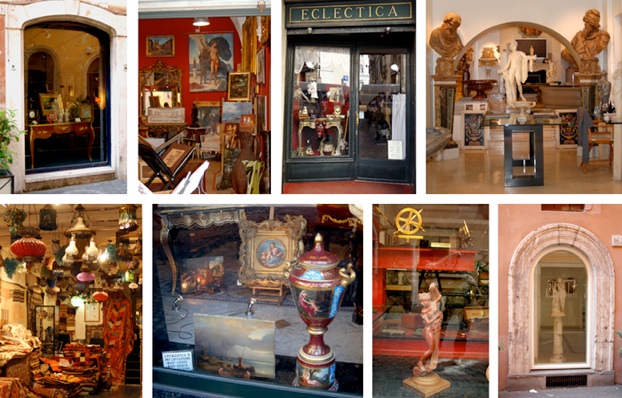
Photo: Shop window displays along the Via dei Coranari.
I ended up at the Palazzo alla Sapienza where two Caravaggio paintings are on display as part of a broader exhibition celebrating his life in Rome, 400 years after his death. The painting of Pope Quinto Borghese has not been seen publicly for 100 years. His tunic was quite freshly painted, almost Velazquez like, even if the composition was rather static. The painting was made more interesting by the fact that it is of the man who ordered the artist’s execution - which he lifted after Caravaggio fled Rome, only to die mysteriously a few years later, aged just 38.
I am sure the 45 minute monologue provided by the gallery guide provided more illuminating facts on his life, for those who understood Italian.
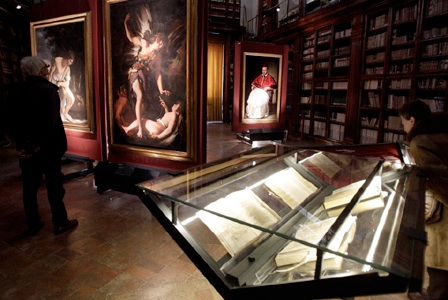
Photo: Caravaggio Show at Palazzo Sapienza with Portrait of Pope Quinto Borghese (background). (AP Photo/Pier Paolo Cito.)
At the end of the courtyard stands a chapel built by Borromini into the existing Palazzo. I admired the way the concave form of the base contrasts with the convex tower, and with the corkscrew tower, creates a dynamic effect of space being sucked in, bulging out and shooting up like an explosion.
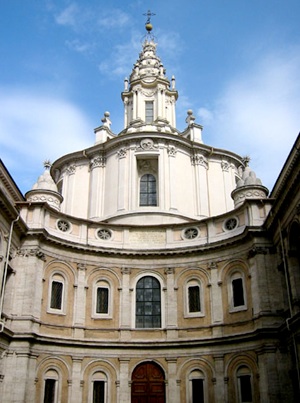
Photo: Church of Sant Yves at La Sapienza.
May 8 Mother’s Day
This image from St Peters Square seemed an appropriate acknowledgement of motherhood. The Latin text means “totally yours” and is my greeting to my wife and mother of my children.
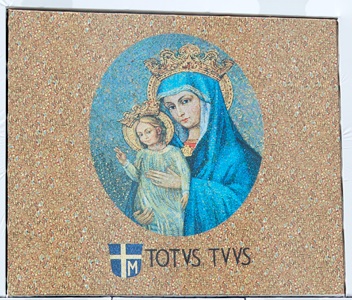
Photo: Image in St Peters Square.
May 11
Enjoyed an outing to Arezzo on Tuesday, located about three hours north east of Rome on the way to Florence. This was my first trip beyond the greater Rome region, and worth the view experienced outside the train window. This included: vineyards and fields cultivated for millennia; rustic stone villas and lime white country roads; hilltop castles and villages; quaint bridges, ancient aqueducts, modern overpasses... At the heart of all this beauty is the contest between man and nature that in the Italian countryside appears to have reached a kind of equilibrium.
Australian artist and primary influence, Jeffrey Smart, lives in Arezzo. I had come to see the frescos that he admires by Pierro della Francesca. The Legend of the True Cross (c. 1450) is contained within a rusticated, late medieval basilica dedicated to St Francis. This storyboard-like cycle tells the story of how wood from the Garden of Eden became the cross on which Christ was crucified and the means by which Christianity triumphed over paganism. It would seem that conflict has been emphasised over salvation, as chronology has been sacrificed to give prominence to Constantine’s battles, in which vertical lances echo the form of the cross.
I found a compositional ordering based on vertical halves that one normally avoids, but which internalises the framing format and narrative sequence. It seemed the use of perspectival space countered by the flattening effect of pure colour generates the real/unreal effect.
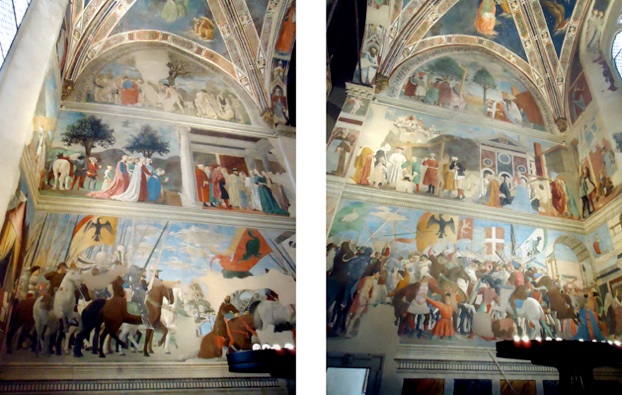
Photo: Legend of the True Cross, fresco, by Pierro della Francesca, Basilica of San Francesco.
The town itself was also strangely surreal. After the crowds of Rome, the Grande Piazza was eerily quiet, like a Di Chirico painting, where the framing towers, medieval shops and classical colonnade felt like a theatre set. Robert Benigni’s film Life is Beautiful was filmed here.

Photo: Piazza Grande, Arezzo.
After a long lunch and leisurely afternoon, I could understand why Mr Smart has not been inclined to return to his home country!
May 12
I totally missed an earthquake that didn’t happen in Rome!
Apparently many Romans left the city yesterday or gathered in public parks fearing a prediction of a catastrophic earthquake made in 1915 might come true. I painted in my studio, ignorant of the anticipated calamity that failed to arrive. Believers no doubt found some consolation in the fact that a moderate earthquake struck Spain instead!
I don’t know if it’s the turps or the effect of losing myself in the process, but I sometimes find it awkward to communicate after a long period in the studio. A two-day painting session was punctuated by two visitors today. Liz Gibson, who works at the Art Gallery of New South Wales and is on the William Fletcher Board, and her partner, Gundo. I showed them around my studio and through the school, and enjoyed their company for lunch even if I felt semi-autistic at the time!
May 13 (Friday)
This auspicious date marks the birthday of my good friend Troy, with whom I have had the good fortune to share seven years of art school. It was also a great day for getting out and about.
Went with the City of Rome group to the Palazzo Spada where the remains of a Roman insulae that collapsed due to an earthquake about 1500 years ago, has been excavated in its basement. Then, on to Santa Cecilia, a 5th century church in Trastevere, (west bank of the Tiber) which according to tradition is built over the house of the saint martyred by Marcus Aurelius.
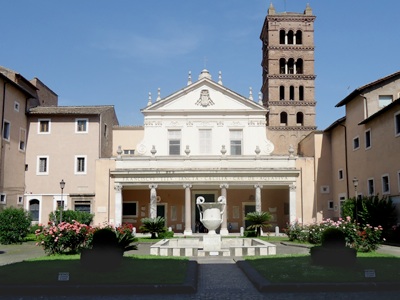
Photo: Santa Cecilia, Trastevere.
There are indeed Roman ruins under the church, but as the Spada basement indicates, this is true of many structures along the river. We explored several rooms belonging to an insula, one with well-shaped holes, believed to be a granary, and one full of sarcophagi.
Then we hiked up the Janiculum, one of the tallest hills in contemporary Rome. It provided a great view of the city skyline punctuated by countless domes.

Photo: Rome panorama from Janiculum Hill.
Our end of term show theme, Fountains and Drains, was well represented here. A baroque fountain graces the top of the hill, and a Roman latrine is located further down.
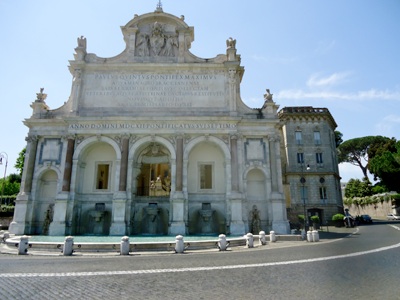
Photo: The Fontana dell’Acqua Paolo , Janiculum Hill, built in 1610-12 to commemorate
the reopening of an aqueduct built originally by Emperor Trajan in 109 AD.
Graffiti in the ancient lavatory would suggest that graphic and literary themes in public toilets have not altered much over the ages. For those interested in deciphering classical smut, the Latin text for one, which I am told is as crude as its content, reads:
Pos tantas epulas et suava vina ut cunnum lingas, quo cula, quo venter.
We had lunch on the steps of Trastevere Fountain in front of the Basilica of Santa Maria, one of the oldest churches in Rome vying for the claim to be the first dedicated to the mother of Jesus. The capitals for its enormous columns were plundered from the Baths of Caracalla.
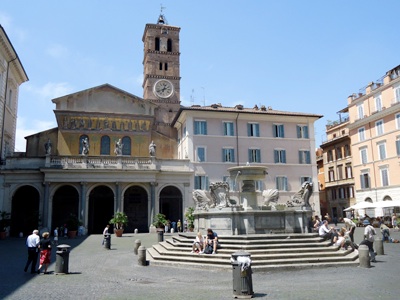
Photo: Trastevere fountain and Basilica of Santa Maria.
Hadrian’s Tomb was our final site for the day. It is more commonly known as Castel Sant’Angelo, after the statue on the top that protects the city from the Bubonic Plague.
The structure consists of a towering cylindrical drum built on a square base, and mirrors the dimensions of the Mausoleum of Augustus located on the opposite bank of the Tiber.
The Ponte Sant’Angelo connects the tomb with the eastern bank, and is lined with angels carved by a team under Bernini’s supervision, circa. 1670.
Hadrian’s tomb was converted into a fortress in 401, and has gone through various phases, its original contents and finishings have long been plundered. The interior spiral ramp might be compared with the spiral frieze on Trajan’s Column in raising the soul of the earthly emperor to the heavens.
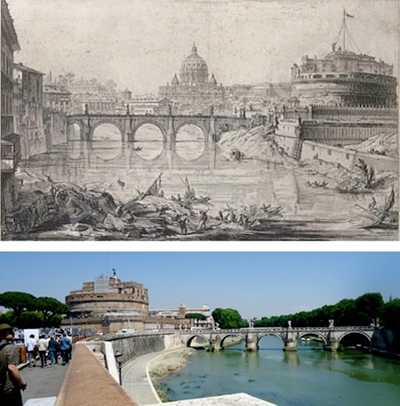
Photo: Hadrian’s Tomb and Ponte Sant’Angelo.

Photo: Queuing for the loo at Hadrian’s Tomb. (Photo: Fiona Mackay)
Got back to the BSR just in time to join an evening excursion to Otricoli, located 44 km north of Rome. We visited the ruins at sites where the school has conducted excavations. The young son of the Count who owns the land met us and provided drinks and antipasto in the porch of a villa. He says he has visited Australia, likes water sports and is keen to compete in the Sydney to Hobart yacht race.
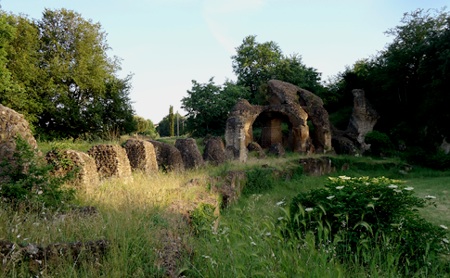
Photo: Ruins at Otricoli.
We then drove up to the hilltop village where we consumed an Asterix-and-Obelix style feast in a subterranean tavern, washed down with jugs of wine, before watching the town’s annual procession. This involved an icon representing the body of the original martyr floating down the river and being escorted up the hill by locals dressed as Roman soldiers and in togas to the church, with its bells pealing, at the top. It was after 1 am when we finally returned to the BSR.
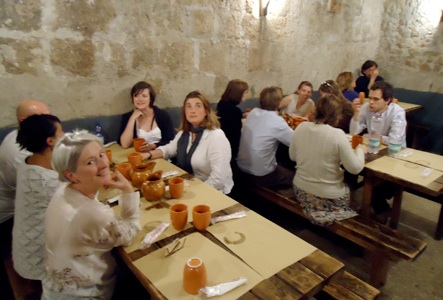
Photo: BSR mob waiting to be fed at Otricoli.
May 16
We looked at various sites on the Quirinal Hill today, including a Mithraeum hidden in a cellar at the rear of the Palazzo Barbarini under an Officers Lounge. This seemed appropriate considering the Mithraeum was a bit of a gentlemen’s club with secret handshakes and initiations (like the Freemasons). Two benches line a recess in this 2nd century vaulted chamber, with a sanctuary at the end, contained originally within a second vault, rusticated to resemble a cave, and with an altar in front of it. A fresco shows Mithras killing a bull under a zodiac arch, with sun and moon deities in the corners, and panels recounting various mysteries down each side. The zodiac cycle which begins with Pisces in the fresco appears to have been reversed on the arch above, from the surviving fish image at the opposing end, as if creating a continuous loop that mirrors the seasonal cycles.
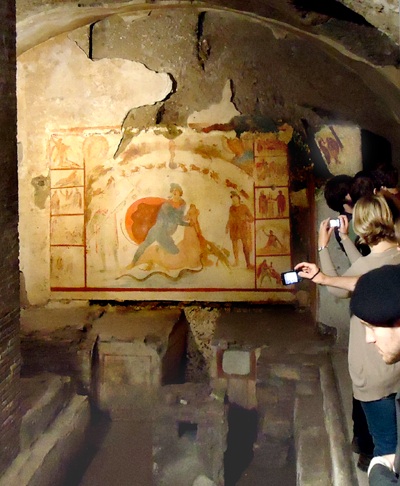
Photo: Mithraeum under the Officers Club at the Palazzo Barbarini.
This intimate interior space appears designed to contain an image of the universe, and brings to mind the astrological charts on the ceiling of the Palazzo Spada.
I thought Mithras in his blue body suit and billowing red cape looked a lot like Superman. His podgy tummy, however, might indicate he needs to cut down on the BBQs with the boys!
May 18
I would like to acknowledge my wife’s 40th birthday with a field of wild flowers from Otricoli.
